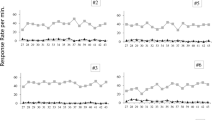Abstract
The acquisition of overt response patterns was recorded during classical conditioning using compound unconditioned stimuli with mice. A 10-sec light was terminated by two sucrose unconditioned stimuli, with the location and movement of the subject automatically recorded during control and stimulus intervals. Conditioning elicited a variety of response sequences, including orienting responses to the light and approach responses to each sucrose dipper, with a concomitant inhibition of antagonistic responses. Classical conditioning with compound unconditioned stimuli, as previous conditioning with compound conditioned stimuli, resulted in an “overshadowing” effect, with a predominance of responses conditioned to one or the other unconditioned stimulus. These results suggest a complex organization of behavior consistent with previous analyses of concurrent and sequential response patterns in experimental schedules.
Similar content being viewed by others
References
ANOKHIN, P. K. 1958. The role of the orienting -exploratory reflex in the formation of the unconditioned reflex. In L. G. Voronin, A. N. Leontiev, A. R. Luria, E. N. Sokolov, & O. S. Vinogradova (Eds.), Orienting reflex and exploratory behavior. Moscow: Academy of Pedagogical Sciences.
ANOKHIN, P. K. 1961. Features of the afferent apparatus of the conditioned reflex and their importance for psychology. In N. O’connor (Ed.), Recent Soviet psychology. London: Pergamon Press.
ASRATYAN, E. A. 1961. The initiation and localization of cortical inhibition in the conditioned reflex arc. Annals of the New York Academy of Sciences, 92, 1141–1159.
ASRATYAN, E. A. 1969. Classical conditioning research and theories. In M. Cole & I. Maltzman (Eds.), A handbook of contemporary Soviet psychology. New York: Basic Books.
BLACK, A. H., & PROKASY, W. F. (Eds.). 1972. Classical conditioning Ii. New York: Appleton-Century-Crofts.
BRADY, J. V. 1971. Emotion revisited. Journal of Psychiatric Research, 8, 363–384.
BYKOV, V. D. 1958. On the dynamics of the orienting-exploratory reaction during the formation of positive and inhibitory conditioned reflexes and their alterations. In L. G. Voronin, A. N. Leontiev, A. R. Luria, E. N. Sokolov, & O. S. Vinogradova (Eds.), Orienting reflex and exploratory behavior. Moscow: Academy of Pedagogical Sciences.
HENTON, W. W., & IVERSEN, I. H. 1978. Classical conditioning and operant conditioning: A response pattern analysis. New York: Springer-Verlag.
HOLLAND, P. C. 1977. Conditioned stimulus as a determinant of the form Pavlovian conditioned response. Journal of Experimental Psychology: Animal Behavior Processes, 3, 77–104.
IVERSEN, I. H. 1975. Concurrent responses during multiple schedules in rats. Scandanavian Journal of Psychology, 16, 49–54.
IVERSEN, I. H. 1976. Interactions between reinforced responses and collateral responses. The Psychological Record, 26, 399–413.
JENKINS, H. M., BARRERA, F. J., IRELAND, C., & WOODSIDE, B. 1978. Signal centered action patterns of dogs in appetitive classical conditioning. Learning and Motivation, 9, 272–296.
KAMIN, L. J. 1969. Predictability, surprise, attention and conditioning. In B. Campbell & R. M. Church (Eds.), Punishment: A symposium. New York: Appleton-Century-Crofts.
KANTOR, J. R. 1959. Interbehavioral psychology. Bloomington: Principia Press.
KONORSKI, J. 1967. Integrative activity of the brain. Chicago: University of Chicago Press.
KONORSKI, J. 1972. Some ideas concerning physiological mechanisms of so-called internal inhibition. In R. A. Boakes & M. S. Halliday (Eds.), Inhibition and learning. New York: Academic Press.
KUPALOV, P. S. 1961. Some normal and pathological properties of the nervous processes of the brain. Annals of the New York Academy of Sciences, 92, 1046–1053.
KUPALOV, P. S. 1969. The formation of conditioned place reflexes. In M. Cole & I. Maltzman (Eds.), A handbook of contemporary Soviet psychology. New York: Basic Books.
MOROSS, G. G., & KAUFMAN, G. I. 1976. Activity monitor for small animals. Physiology and Behavior, 16, 493–495.
PAVLOV, I. P. 1927. Conditioned reflexes. London: Oxford University Press.
RAY, R. D. 1977. Psychological experiments as interbehavioral systems: A case study from the Soviet Union. The Psychological Record, 27, 279–306.
RAY, R. D., & BROWN, D. A. 1975. A systems approach to behavior. The Psychological Record, 25, 459–478.
RAY, R. D., & BROWN, D. A. 1976. The behavioral specificity of stimulation; a systems approach to procedural distinctions of classical and instrumental conditioning. Pavlovian Journal of Biological Science, 11, 3–23.
RAY, R. D., & RAY, M. R. 1976. A systems approach to behavior Ii: The ecological description and analysis of human behavior dynamics. The Psychological Record, 26, 147–180.
RESCORLA, R. A., & WAGNER, A. R. 1972. A theory of Pavlovian conditioning: Variations in the effectiveness of reinforcement and nonrein for cement. In A. H. Black & W. F. Prokasy (Eds.), Classical conditioning Ii. New York: Appleton-Century-Crofts.
SECHENOV, I. M. 1965. Reflexes of the brain, Cambridge: M.I.T. Press.
SHETTLEWORTH, S. J. 1978. Reinforcement and the organization of behavior in golden hamsters: Pavlovian conditioning with food and shock unconditioned stimuli. Journal of Experimental Psychology: Animal Behavior Processes, 2, 152–169.
STADDON, J. E. R. 1977. Behavioral competition in conditioning situations: Notes toward a theory of generalization and inhibition. In H. Davis & H. M. B. Hurwitz (Eds.), Operant - Pavlovian interactions. Hillside, N.J.: Lawrence Erlbaum.
STADDON, J. E. R., & SIMMELHAG, V. L. 1971. The “superstition” experiment: A reexamination of its implications for the principles of adaptive behavior. Psychological Review, 78, 3–43.
WAGNER, A. R., & RESCORLA, R. A. 1972. Inhibition in Pavlovian conditioning: Application of a theory. In R. S. Boakes & M. S. Halliday (Eds.), Inhibition and learning. New York: Academic Press.
ZENER, K. 1937. The significance of behavior accompanying conditioned salivary secretion for theories of the conditioned response. American Journal of Psychology, 50, 384–403.
Author information
Authors and Affiliations
Rights and permissions
About this article
Cite this article
Henton, W.W., Spohn, W.D. Classical Conditioning with Compound Unconditioned Stimuli. Psychol Rec 30, 47–60 (1980). https://doi.org/10.1007/BF03394654
Published:
Issue Date:
DOI: https://doi.org/10.1007/BF03394654




